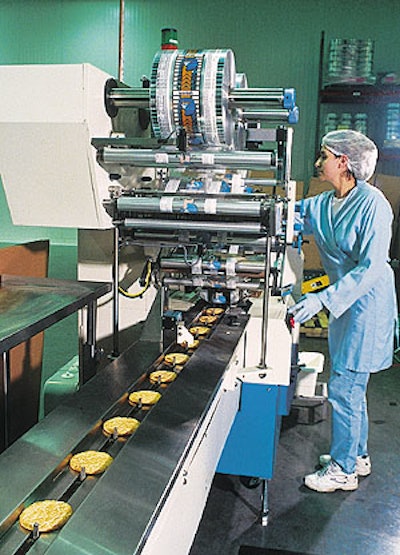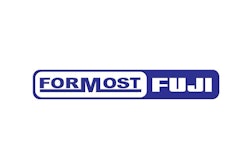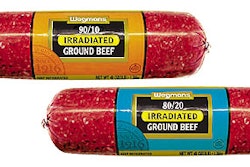
Entering year 2002, the airline market has been anything but robust. However, when the recovery comes, Jana’s Classics of Tualatin, OR, will be ready with twin packaging lines that tripled the plant output when they were installed.
Until travel took a time-out last fall, Jana’s was wrapping nearly 300 cookies/min in individual pouches to be frozen and shipped to airlines. That was accomplished on two wrapping lines that were commissioned about 18 months ago to take the output of the plant’s second baking oven.
That doesn’t sound particularly unusual until you know that five years ago, Jana’s total volume was produced and packaged by contract packagers. And 12 years before that, Jana Taylor was just beginning to use her home economics degree to create recipes for frozen cookies and cookie dough for the institutional markets.
Before the wrapping lines and new oven were installed, Jana’s used older machines that were neither efficient nor economical to operate. Because they were hand-fed, labor costs were high and speeds were not. But when the company sought to improve output and efficiency, it didn’t have the in-house expertise. So Val Brown, Jana’s vice president, called in Campbell-Hardage (Athens, GA) to provide turnkey design and engineering services.
“We took responsibility for taking the product from the oven and cooling tunnel to where they hand-pack the wrapped cookies into cases,” says Tim Hardage, president of Campbell-Hardage.
C-H recommended and Jana’s bought two automated Fuji-Formost FW-340mII horizontal overwrappers from Formost Packaging Machines (Woodinville, WA). The wrappers are placed parallel and six feet apart, and each is fed by a 10’-long flighted infeed conveyor designed and manufactured by C-H. “We call them self-loading infeeds,” Hardage says, “because they are activated by a photocell that looks for the flow of cookies. Depending on that flow of cookies, the photocell works through a PLC to adjust the speeds of the infeed and of the wrapper.”
In turn, the infeeds are supplied by a 100’-long, 42”-wide belt conveyor with C-H-built rail diverters that carry cookies from the oven and cooling steps.
Ideal to run at 270/min
“Typically, we run each wrapper at about 135 packages per minute,” says Jeff Richtmyre, Jana’s project engineer. “Until the slowdown in air travel, we used to regularly run these shift after shift, day after day, without downtime except for normal maintenance.” For most of the cookie varieties that are packed for airlines, simple handwheel adjustments can change the width of the wrapper.
Once the machinery was installed, training for Jana’s operators was provided by Formost, and the new lines went into operation quickly. Of course, this was back in the days when orders from the airlines were keeping the Oregon plant hopping. “Now,” says Richtmyre, “this business is way down because the airlines are hurting. But we’ll be ready for them when business returns.”
The process at the plant combines high efficiency and top quality. After the ingredients are mixed and the cookies are deposited onto conveyors leading to the baking oven, the cookies are carefully monitored on-line for moisture and salinity by technologists, who also check for physical characteristics like height, weight, diameter, and circularity.
Throughout the plant, microbiologists check air and environmental conditions. Once the cookies emerge from the computer-controlled ovens, they’re cooled on their way to the diverters that gently direct them into the infeed of each wrapper. Once in their flights in the wrapper, cookies move toward the forming box where they enter a tube of film made with a fin seal. Separate single cookie packs are made by rotary, crimping heat sealers for the top and bottom. Inside the sealers are hollow metal tubes that provide resistance-type heating to transfer the heat to the packaging material.
“This type of heater tends to even out the heat and temperature across the length of the crimper and knife,” Richtmyre says. “They’ve worked well for us. Our seal integrity has been very good.”
The airline cookies typically use a 1.6-mil lamination of oriented polypropylene film from Cello-Pack (Cheektowaga, NY). Most are flexo-printed in four or five line colors, says Michael Foey, Cello-Pack’s representative who works with Jana’s.
Although Jana’s airline market is a bit soft now, Richtmyre says the company is very satisfied with the wrappers. “We like their high output and their reliability. Plus they have automatic splicing. We’re so pleased that we don’t even have a back-up machine.”
Changeover on the wrappers is seldom an issue. Although it does involve some hand tools, Richtmyre says one person can do a major change in just 15 minutes, usually less time than needed to change the pre-packaging part of the line. —AO

























